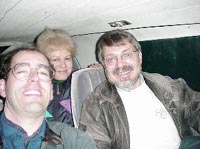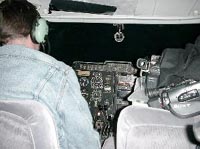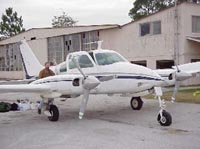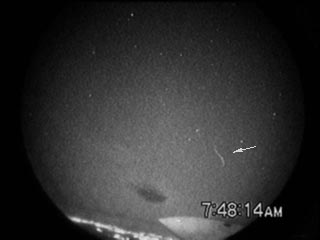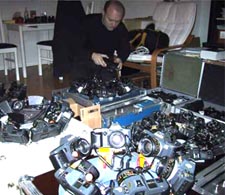|
Leonid MAC |
| home |
| View the shower |
| Mission Brief |
| Science Update |
| Media Brief |
| links |
2000 Leonid MAC
Left: Researchers Peter Jenniskens, Ludmilla Kolokolova and Bo Gustafson during the 2000 Leonid mission. Middle: Pilot Pat Bainter next to intensified cameras. Right: The Cesna 130 aircraft.
November 17, 2000LEONIDS PEAK AS EXPECTED THURSDAY NIGHT Florida - Mainly faint Leonid meteors were observed at around 3 a.m. Thursday night, when Earth crossed the dust trail of comet Tempel-Tuttle's 1932 passage by the Sun. The shower was observed from a site near Jupiter (Palm Beach County), at ISTEF/KFC (south of Volucia county), and from a small aircraft. Onboard a twin engine Cesna 130 aircraft, Peter Jenniskens of the SETI Institute at NASA Ames Research Center and Bo Gustafson and Ludmilla Kolokolova of the University of Florida at Gainesville had the best view of the shower. Meteors were recorded with intensified cameras at a rate of 6 per minute at the peak of the shower, which occurred around 3 a.m. (7 UT) much as predicted. The airborne effort was made possible by Gustafson and pilot Pat Bainter of Gulf Atlantic airways at Gainesville, Florida. A new Data Grid Geo-ID Mk 1 global positioning system was tested that recorded the aircraft position to cm accuracy. Takeoff was at 1:30 a.m. and it took about 1 hour before cloud cover was low enough to have a clear sky. Most of the observations were performed over the Everglades and the Florida Keys. No bright fireballs were seen, but the intensified cameras recorded numerous visible meteors of +4 and +5 magnitude that are hard to observe from the ground. The observations trace the shower profile nicely. The mission commenced until 10:30 UT, followed by a landing at Fort Lauderdale for refueling and the flight back to Gainesville. Left: ISTEF mobile telescope platform being prepared for Leonid observations on afternoon Nov. 15.At NRC/ISTEF, a BMDO facility at Kennedy Space Center, clouds hampered observations most of the night. An array of infrared imagers and optical cameras by All Tietjen and colleagues of ISTEF were trained at the open clearings between clouds. Similar narrow band infrared imagers are projected for use in future airborne missions. Pete Gural provided fireball detection support, testing a new all-sky detection and real-time warning procedure. Unfortunately, no bright meteors were seen that night. At Jupiter, David Nugent and Mike Palimeti observed under mostly clear skies from about 20 minutes prior to the peak of the shower until dawn. The site provided stereoscopic support for ISTEF/KFC in case of bright fireballs and persistent trains. A bright Taurid fireball was observed low in the South early in the night, but no bright Leonids. Apparent Leonid rates peaked just after 3 a.m. local time. Arizona - The Aerospace Broadband Array Spectrograph (BASS) was taken to the Mount Lemmon Observing Facility (MLOF) for a combined astronomical observing run on the 60 (1.5 m) telescope and Leonid observations with a 4 off-axis parabola telescope on a tripod. The Aerospace team, Catherine Venturini, Daryl Kim, and Ray Russell, operated the spectrograph and co-aligned camera from about midnight until 6:30 AM on three nights. The BASS instrument is a helium-cooled spectrograph operating in the 3-14 micron range of the spectrum, with a wavelength-dependent resolving power of 30-120. This same sensor had been flown on the FISTA for the past two years, and it was hoped that a bright fireball or persistent train might be seen from the ground this year. The cold conditions (15-20 F) and clear skies provided a very good environment for making thermal IR observations. An intensified CCD camera kindly provided by Peter Jenniskens was co-aligned with the IR spectrograph to document the objects in the field of view. The IR line of sight was also co-aligned with a small spotting telescope using the moon as the source. IR spectroscopy of a 0.25 degree FOV on the moon was obtained on both Nov. 16 and 17 UT, verifying the successful alignment and performance of the spectrograph. Unfortunately, although many bright meteors and several bright wakes (1-5 seconds in duration) were seen, no fireballs or persistent trains were seen. The bright moon is believed to have obscured many of the fainter meteors, although the video records will need to be analyzed for ZHR estimations.
Right: Mount Lemmon Observatory Arizona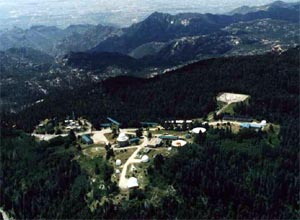 At Mount Lemmon observatory
were 4 additional video cameras for flux measurements and a visible spectrograph, operated by
Mike Koop.
Each video camera had a FOV
of 30x40 degrees and they were arranged with two cameras pointing south and two
pointing north at angles of 40 degrees from each other within each pair. The
Visible spectrograph had a field of view of the zero order of 20 degrees, a wavelength range
of 400-900 nm and a resolving power of 120. These instruments were designed to
provide an accurate database
for flux estimations, provide visible spectroscopy of the Leonids, and
support the IR data collection effort in the event persistent trains were
seen.
At Mount Lemmon observatory
were 4 additional video cameras for flux measurements and a visible spectrograph, operated by
Mike Koop.
Each video camera had a FOV
of 30x40 degrees and they were arranged with two cameras pointing south and two
pointing north at angles of 40 degrees from each other within each pair. The
Visible spectrograph had a field of view of the zero order of 20 degrees, a wavelength range
of 400-900 nm and a resolving power of 120. These instruments were designed to
provide an accurate database
for flux estimations, provide visible spectroscopy of the Leonids, and
support the IR data collection effort in the event persistent trains were
seen.
In addition, a UV spectrograph and co-aligned visible intensified camera were successfully operated by Rick Rairden of Lockheed Martin for the two mornings Nov 17th 0630-1235 UT and Nov 18th 0710-1315 UT. The UV wavelength range was 320-405 nm with spectral resolution of 2 nm in first order. Both camera fields of view were approximately 9 x 12 degrees. These instruments were to collect broadband energy measurements in the visible, and UV spectroscopy of the same meteors coincident in time to allow more detailed analysis of the composition and time dependent chemistry of the meteors captured in the data streams. The UV channel was provided by Stephen Mende, UC Berkeley. California - Californian observers, too, happened to have clear skies last night. A two-station photographic network was established, using the site's benefitial low Moon position in the sky at the peak of the outbursts. California Meteor Society members Jane Houston, Pete Zarubin, Ming Li, Morris Jones, Akkana Peck, Dave North and David Smith gathered at a site in the foothills just south-east of San Jose on United Technology Corporation property. Two batteries of cameras were operated, a high camera platform with 4 cameras and a low camera platform with 13 35mm cameras. 10 minute exposures were taken from 11 pm until 3 a.m. The camera site was located near a large tree that we tried to use to shade the Moon that rose overhead. Ming Li also operated a video camera equipped with a fish eye lens and a low light level image intensifier. The sky was clear and many stars, bright and faint were visible until the moon rose. 54 km further south, Chris Angelos, Karl Anderson,and colleagues operated similar equipment from Fremont Peak Observatory. Jane Houston reports that it was cold and the estimated Limiting Magnitude (prior to moon rise) is 5.9 and after moonrise, this dropped to 5.4. At 08:18:30 a -2 Leonid was observed that should have been recorded by the cameras.
Utah - Mike Taylor reports excellent seeing conditions at Beark Lake, but very few meteors were sighted and recorded. Radar data were recorded as well but wait analysis. Massachusetts - Joe Kristl and coworkers are clouded out. November 18, 2000LEONIDS PEAK AGAIN FRIDAY NIGHT: BIGGER AND BRIGHTER Florida - "This shower is spectacular! I saw at least 25 bright ones tonight, and didn't see any last night", said Pat Bainter, Cesna 130 aircraft pilot in response to air traffic controlers in Miami, Florida. The curious requests for flight path changes in response to local cloud cover and the occurrence of bright meteors peaked their interest, and after a short explanation the mission received all possible support. The aircraft was chartered for the occastion by meteor astronomers Bo Gustafson and Peter Jenniskens, to be above clouds and lower atmospheric haze and measure the Leonid shower's activity during the encounter with comet Tempel-Tuttle's dust ejected in 1866.
Numerous relatively bright Leonids were seen, immediately after clouds were cleared at 6 UT. This was in sharp contrast with the previous night when most Leonids were relatively faint. A bright -8 Leonid fireball was recorded at 7:46:59 UT in south-western direction from Fort Lauderdale, which left a long-lasting persistent train. No other bright fireball was seen that night. Overall rates were similar, or perhaps slightly better, as in the previous night, but with many more +2 and +1 Leonids. Observations continued until 9:30 UT, when the aircraft ran low on fuel and landed in Fort Lauderdale.
Left: Diffuse beginning of the 07:46:59 UT fireball as recorded from the Cesna 130 aircraft. Right: The fireball's persistent train in a panoramic view.With automatic all-sky support continuing at ISTEF, Pete Gural teamed up with David Nugent at Jupiter, Florida, to escape the cloud deck that covered most of northern Florida. Similar relatively bright meteors were reported as well as a second fireball in southern direction at around 10 UT. No new train spectra could be recorded. The site was clear for most of the night, although Moon light was scattered on low atmospheric haze. ISTEF reported clear weather for the latter part of the night, just after the outburst. Numerous bright Leonids were seen, but no persistent trains that could be observed with the telescope assembly. The reported fireballs were too far south for viewing from the Cape. Arizona - Mount Lemmon observers reported another cold but crisp night. Meteor activity is high and several near-UV and visible spectra may have been taken. Meteor rates are recorded. Again, no persistent trains were observed. California - Californian observers have warmer and more clear conditions than the night before. At FPO, Chris Angelos observed with Sandra Macika, Mike Salo and Rick Morales. Rates were significantly higher and a bright -6 meteor at 8:03:34 UT stole the show. The UTC crew consisted of Ming Li, Peter Zarubin and Terry Kahl. Terry stayed until 3 AM, Ming and Peter until daybreak. The evening sky was clear. The same set-up was used as the previous night except the site was moved away from the large tree, more into the open. The video camera appeared to work OK and a flag was jerry rigged to block out the moon. Massachusetts - Joe Kristl passes along that his team had moderate success observing the Leonids from their site at Haystack Observatory in Westford MA, on the morning of Nov 18. The previous night was completely clouded out, but in the night of Nov 17/18 the weather was clear, although quite cold. The temperature outside dipped into the 20's. Kristl operated a new InGaAs camera which recorded at least 7 Leonids in broad-band emission between 0.9 and 1.65 micron, images that were fully calibrated. At 08:02 UT, a bright fireball appeared to the south-southwest and ended in a nice persistent train. The instrument was quickly pointed at the train. Although clearly seen at visible wavelengths, the near-IR signature was weak in comparison with the airglow background. Left: Campers provide a mobile station in Spain (photo: Hans Betlem). Middle: Photograph of a -6 Leonid fireball (november 18, 05:53:12 UT) by Jaap van 't Leven from Algarve, Portugal. Right: Preparing the camera batteries in Portugal (photo: Casper ter Kuile).Spain - Hans Betlem and colleagues of the Dutch Meteor Society report successful observations of the 1733 trail from Spain and from Portugal in the night of November 17/18. Tens of meteors were photographed multi-station by two teams some distance appart in each country. Hans Betlem reports 14 of 19 films developed and a score of 192 Leonids so far. At one of the two Spanish sites, Jiri Borovicka of Ondrejov Observatory reports several low-resolution video spectra as well as a low-resolution spectrum of a persistent train. Borovicka reports that it looks quite similar to last year's spectrum at first sight (a featureless continuum) but is of lower quality. Canary Islands - Hajime Yano and Dr. N. Ebizuka went to La Palma, Canary Islands, to view the Leonid shower. They observed with normal miniDV-II and a CCD imager and caught both the 1733 peak and the rising phase of the 1866 filament, with some spectroscopy attempt of persistent trains. |






